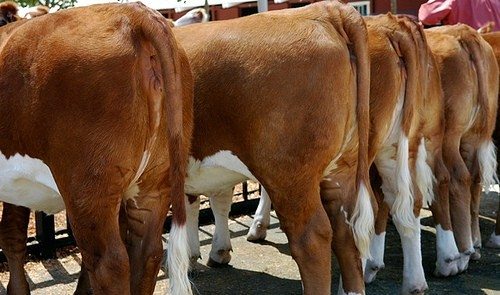It might have seemed a little out of place at the time as over 100 million TV viewers of the 2011 Super Bowl were treated to a slick commercial showing electronic cows playing in a rock band. The 32-second ad described how GE harnesses biogas technology “to create energy using organic waste from sources like landfills, compost, even cows,” adding “it’s something any fan of renewable energy can get excited about.”
Since then major US food giants Kraft and Campbell’s have unveiled plans to invest in biogas plants, which turn organic waste into methane to power onsite generators, while one of the world’s largest companies, Apple, is seeking approval to ramp up its biogas fuel cell project at its North Carolina data centre.
In Germany, 14.2 per cent of its renewable energy from is sourced from biogas, supported by a robust system of feed-in tariff subsidies, helping the economy reach the point where a quarter of its electricity comes from renewable sources.
Meanwhile, predicted growth is just as impressive in the UK. Charlotte Morton, the head of the UK Anaerobic Digestion (AD) and Biogas Association, said AD could generate 40TWh of biogas, equivalent to 10 per cent of the country’s domestic gas demand. A £21 million organic waste processing facility at East London’s Dagenham Dock has been the first waste project to benefit from support from the Green Investment Bank.
Internationally, power generation capacity from commercial biogas facilities will more than double to 29.5GW over the next decade, according to a recent report from Pike Research. Biogas can meet demand in power, heat, and transportation markets, address a range of environmental issues, and may be deployed on both an integrated and distributed basis, Pike’s senior research analyst Mackinnon Lawrence says.
“What’s more, the expansion of the biogas industry, which uses stable and well-understood processes, hinges on innovative applications and business models rather than breakthrough technologies,” he adds.
Although biogas has been slow off the blocks in Australia, the technology is fast becoming a commercially viable proposition – a proposition that finance provider Low Carbon Australia (LCA) is keen to continue developing.
Meg McDonald, chief executive of LCA – a Commonwealth government established organisation that provides finance to businesses for energy efficiency and carbon abatement projects – says Australia’s biogas sector holds tremendous potential for the intensive agriculture, meat and food processing industries, since it offers significant opportunities for cost-effective energy savings, renewable energy generation and carbon abatement.
Agriculture and meat processing industries alone could abate over 2 million tonnes of greenhouse gas emissions a year for a capital investment of around $300 million.
“LCA focuses on quality projects that generate market value, those that are investment-ready, and which achieve significant energy savings and cost-effective carbon abatement, creating impact across industry and encouraging further private-sector investment in the sector,” Ms McDonald said.
Deploying biogas technology makes sense on two fronts – as a renewable energy source derived from existing processes, and as an efficient way of reducing emissions of methane – 21 times more potent a greenhouse gas than carbon dioxide (CO2).
According to BioEnergy Australia, anaerobic digestion emits only 11grammes of Co2 per kWh, just behind wind energy and hydroelectricity. As a comparison to fossil fuels, biogas is even more compelling with natural gas emitting 443g/kWh and un-scrubbed coal over a kilogram/kWh.
Late in 2012, LCA announced part-financing for garden compost manufacturer Richgro’s $3.3 million biogas project with a five-year loan.
Taking into account carbon emissions reduction from electricity production alone (excluding gas consumption) and diverted waste from landfill, the project will save in the order of 142,722 tonnes of CO2-equivalent (CO2-e) over its 20-year life.
The 2MW Richgro project will be used as a reference site to go out into the market and install more systems across the country.
Hamish Jolly, a director at Biogass Renewables – the company building the plant for Richgro – says: “For companies that have a useable waste stream, a use for the organic digestate by-product and an on-site energy requirement, that tripartite model stacks up fantastically well, ignoring any of the energy export side of it.”
LCA has a strategic alliance with Quantum Power, whereby it will provide upfront finance to the biogas developer’s clients for project implementation, construction and commissioning, thus helping overcome a financial barrier which has often prevented such projects proceeding.
Richard Brimblecombe, managing director and chief executive at Quantum, said that despite these positive drivers the biogas industry in Australia continues to be seen as an emerging industry.
“It hasn’t reached the mainstream yet and for that reason I don’t think the financiers are fully aware of the opportunities. What we’re seeing is, as more projects are delivered, there is an emerging understanding of costs and risks,” he said.
This is where LCA plays its role, helping bridge the gap by working with finance partners to offer financing at market-competitive rates, adjusted for risk-weighting and on more flexible terms than commercial financiers can offer in isolation. Finance solutions are flexible and designed to match repayments to energy savings or project revenue generation.
The announced merger of LCA into the Clean Energy Finance Corporation offers the prospect to significantly scale up this type of financing for biogas projects in Australia
Biogas-fuelled generation projects hold several advantages over solar and wind farms in the commercial and industrial sector. “It’s not reliant on weather conditions for performance. Generally, you can’t generate electricity at peak load periods with solar and obviously with wind you have peak demand when there’s very little wind,” says Quantum’s Brindlecombe.
“With biogas you have the ability produce a consistent power output, 24 hours a day, seven days a week. There’s a real opportunity exploit to develop the biogas market in Australia, particularly given we do have a fairly substantial livestock industry.”
That’s certainly something to get excited about.
Oliver Wagg is a communications consultant working in the areas of renewable energy and sustainable business practice. He is currently undertaking a communications project for Low Carbon Australia










